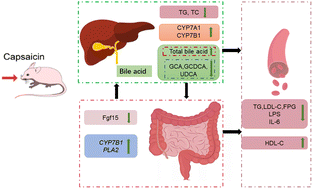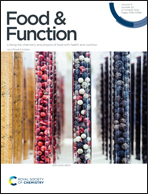Capsaicin regulates dyslipidemia by altering the composition of bile acids in germ-free mice†
Abstract
The improvement of lipid metabolism by capsaicin (CAP) has been extensively studied, mostly with respect to the vanilloid type 1 (TRPV1) ion channel and intestinal flora. In this study, a model was established in germ-free mice by using resiniferatoxin (RTX) to ablate TRPV1 ion channels. Bile acid composition, blood parameters, and colonic transcriptome analyses revealed that CAP could improve dyslipidemia caused by high-fat diet even in the absence of TRPV1 ion channels and intestinal flora. CAP fed to germ mice decreased the concentrations of low-density lipoprotein cholesterol (LDL-C), triglycerides (TG), fasting blood glucose and fasting insulin, increased the concentration of high-density lipoprotein (HDL-C), and decreased the levels of plasma endotoxin and pro-inflammatory factor interleukin 6 (IL-6). Furthermore, CAP could affect both classical and alternative pathways of cholesterol conversion by changing the composition of bile acids, reducing the concentrations of glycocholic acid (GCA), ursodeoxycholic acid (UDCA) and glycochenodeoxycholic acid (GCDCA). First, changing the composition of bile acids inhibited the expression of colon Fgf15. CAP promoted the expression of Cyp7a1 (Cytochrome p450, family 7, subfamily a, and polypeptide 1) in the liver, and thus reduced TC and TG levels. In addition, it could change the composition of bile acids and increase the expression of Cyp7b1 (Cytochrome p450, family 7, subfamily b, and polypeptide 1) in the colon, increase Cyp7b1 protein in the liver and thus inhibit fat accumulation. In conclusion, CAP could alter the composition of bile acids and promote the conversion of cholesterol to bile acids, thereby improving lipid metabolism abnormalities caused by a high-fat diet.



 Please wait while we load your content...
Please wait while we load your content...